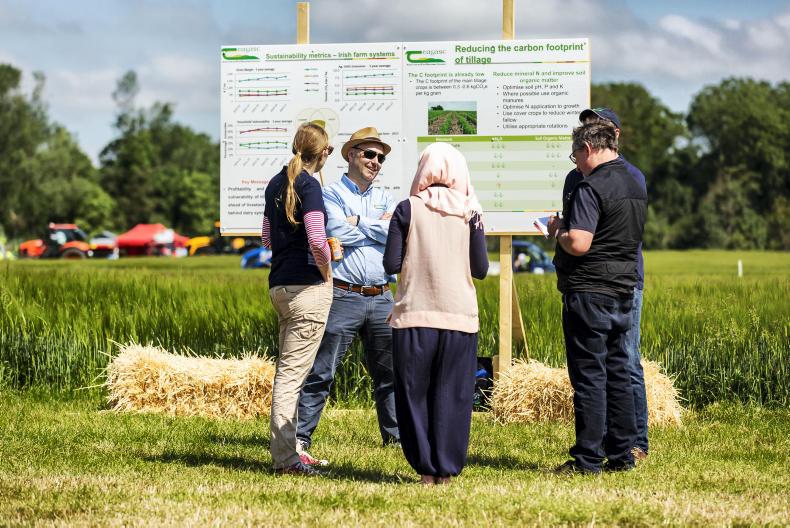Although tillage farmers have low greenhouse gas emissions compared with livestock enterprises, Teagasc researcher Macdara O’Neill told visitors at last week’s Crops & Spreaders open day that they can still minimise their contribution to climate change.
“The carbon footprint on tillage farms is already low, with main tillage crops only producing between 0.3kg and 0.6kg carbon dioxide equivalent per kg grain,” O’Neill said.
Yet, one of the more harmful greenhouse gases produced by the tillage sector is nitrous oxide (N2O), which is formed from the application of fertiliser.
“One way to reduce nitrous oxide is to use ploughing instead of minimum tillage systems,” O’Neill said.
However, this has other environmental consequences.
Another way to reduce nitrous oxide is to “optimise your nitrogen (N) application, so use N in exactly the correct timings, use the precise amounts that can maximise plant uptake and minimise microbial use.”

How tillage farmers can reduce their carbon footprint explained by Teagasc.
Organic matter in tillage soils is also very important, with a lot being lost during the intercropping period when the soil remains idle and undisturbed.
A major carbon loss occurs during this period. “No photosynthesis takes place during intercropping. There is no vegetation and a lot of soil respiration occurs, emitting a lot of carbon into the atmosphere,” said O’Neill.
One way to limit carbon loss is to reduce the period from harvest to sowing. This can be done by sowing a winter crop or a cover crop if the farmer is deciding to grow a spring crop the following year.
“Straw incorporation is another method used to increase carbon matter in the soil, rather than export straw off the field. The straw decomposes into the soil, which is transformed into organic matter,” said Macdara.
He added that the take-home message for tillage farmers is “to reduce the intercropping period, have as much vegetative growth on the land as possible, increase crop rotations and choose a system that best suits your farm”.
Read more
The climate actions on the big MACC menu
How tillage farmers can reduce their carbon footprint
Full ammonia transparency at Hillsborough
Although tillage farmers have low greenhouse gas emissions compared with livestock enterprises, Teagasc researcher Macdara O’Neill told visitors at last week’s Crops & Spreaders open day that they can still minimise their contribution to climate change.
“The carbon footprint on tillage farms is already low, with main tillage crops only producing between 0.3kg and 0.6kg carbon dioxide equivalent per kg grain,” O’Neill said.
Yet, one of the more harmful greenhouse gases produced by the tillage sector is nitrous oxide (N2O), which is formed from the application of fertiliser.
“One way to reduce nitrous oxide is to use ploughing instead of minimum tillage systems,” O’Neill said.
However, this has other environmental consequences.
Another way to reduce nitrous oxide is to “optimise your nitrogen (N) application, so use N in exactly the correct timings, use the precise amounts that can maximise plant uptake and minimise microbial use.”

How tillage farmers can reduce their carbon footprint explained by Teagasc.
Organic matter in tillage soils is also very important, with a lot being lost during the intercropping period when the soil remains idle and undisturbed.
A major carbon loss occurs during this period. “No photosynthesis takes place during intercropping. There is no vegetation and a lot of soil respiration occurs, emitting a lot of carbon into the atmosphere,” said O’Neill.
One way to limit carbon loss is to reduce the period from harvest to sowing. This can be done by sowing a winter crop or a cover crop if the farmer is deciding to grow a spring crop the following year.
“Straw incorporation is another method used to increase carbon matter in the soil, rather than export straw off the field. The straw decomposes into the soil, which is transformed into organic matter,” said Macdara.
He added that the take-home message for tillage farmers is “to reduce the intercropping period, have as much vegetative growth on the land as possible, increase crop rotations and choose a system that best suits your farm”.
Read more
The climate actions on the big MACC menu
How tillage farmers can reduce their carbon footprint
Full ammonia transparency at Hillsborough







 This is a subscriber-only article
This is a subscriber-only article










SHARING OPTIONS: